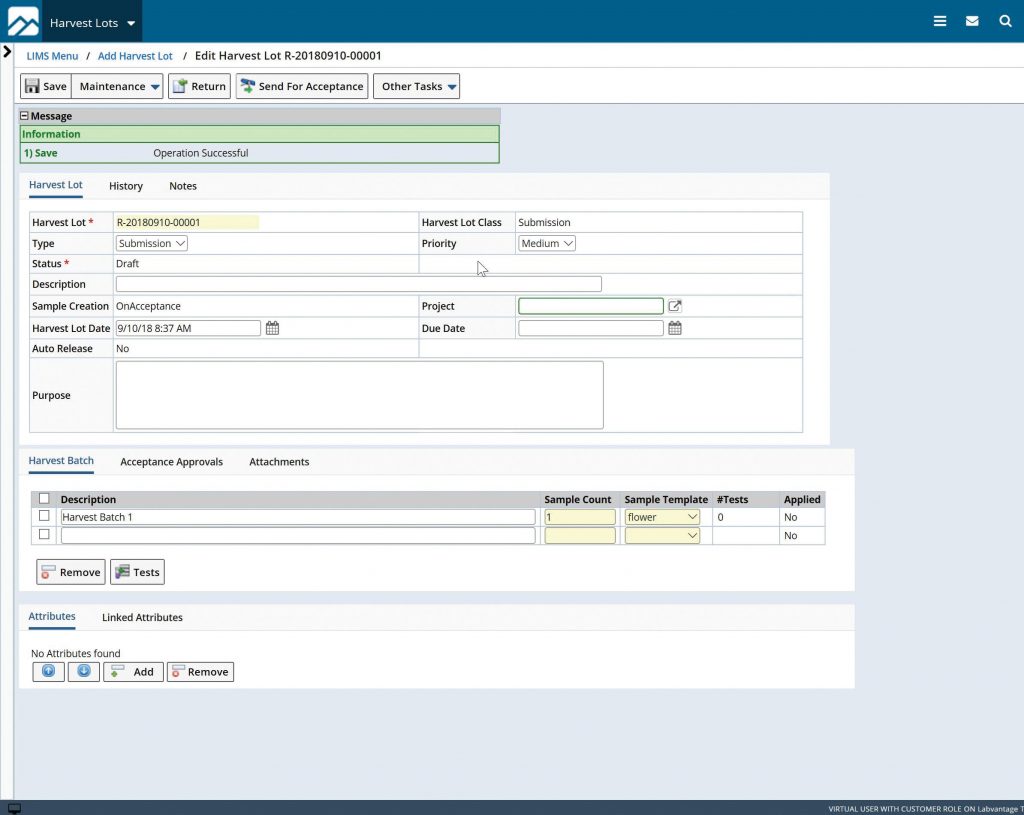As cultural and legislative support for the cannabis industry continues to grow around the world, many laboratories are adapting their testing capabilities to meet rising customer demand.
To make this emerging opportunity a success, labs must navigate a constellation of business needs and regulatory imperatives. These include:
Maximize return on investment (ROI). The cost of instrumentation is high, and margins are low. To reach revenue targets, labs must operationalize a highly efficient, reliable, and reproducible end-to-end workflow.
Maintain compliance. In the United States, adjacent states have divergent (and frequently revised) regulatory demands, while labs themselves have internally driven QC standards. Efficient teams require a system capable of supporting internal and external compliance measures.
Acquire and retain strategic customer relationships. The cannabis testing industry, defined by competition and aggressive turnaround times, is intensely customer-driven. To survive, labs must offer an efficient and modern experience for growers and extractors.
This tutorial will demonstrate how a web-based laboratory information management system (LIMS), purpose-built for the cannabis industry, can help labs meet these demands from one end of a typical workflow to the other.
Service Requested through Customer-Facing Portal
The Growers’ Portal provides customers with a frictionless mechanism for preparing and submitting requests (Figure 1).

and establish a due date.
Growers can enter details about their sample (Is it an edible? A flower? A concentration?). They can specify which tests they require and on what timeline. Then, using a preconfigured built-in list of mandatory information, they can provide details like the METRC ID or the mass of each batch. (METRC is the cannabis inventory accounting software designed for government agencies regulating legalized marijuana.) The grower may also attach a photo, which can be reproduced on the final certificate of analysis (CoA) for marketing purposes.
Growers can pause and reactivate this request process at any time, giving those who anticipate a large harvest the opportunity to work ahead. The Harvest Lot Menu Screen gives them access to all of their harvest lot requests at various stages of service, from new through historical (Figure 2).

Request Reviewed and Next Steps Assigned through Interface
Once the grower has submitted a request for service, the lab receives notification.
Administrators and lab managers who want visibility over incoming and active requests can use a Request Navigator feature. Instead of running a search on a specific sample, the navigator provides users with a bulk view of all activity and the option to drill down into the details of any particular request.
Requests that are missing critical information or have problematic timelines are pushed back to the grower with notes; those with all necessary details are accepted. At this point, the LIMS prompts the first automated eSignature (eSig) event.
At strategic intervals throughout the cannabis testing process (such as when accepting a request), the cannabis LIMS requires a password-protected eSig authorization before proceeding.
The eSig function is part of an end-to-end digitized chain of custody, which can be configured to contain as much or as little detail as required. This allows auditors or other interested individuals to quickly and easily investigate who interacted with a sample, and at what point in the workflow, by following the eSig breadcrumb trail.
LIMS Tracks Sample Collection and Monitors Test Preparation Methods and Materials
Once a request is approved, the lab uses its LIMS to delegate a sampler who collects the sample from the grower. Each collected sample is photographed and assigned a digital barcode in the LIMS, replacing the error-prone tradition of manual tracking. At this stage, the LIMS interfaces with METRC to signal that a sample is undergoing testing; such integrations also contribute to a more efficient workflow between grower, lab, and regulator.
As technicians prepare the sample for testing, the LIMS works in the background to monitor the test-readying process. It can signal when a reagent’s inventory is low, or when an instrument or an analyst requires recertification. Such automated oversight drives efficiencies in both small organizations (by liberating a limited staff from time-consuming administrative duties) as well as high-throughput labs with multiple locations.
Tests Conducted with Instrumentation Synced to the LIMS
A cannabis LIMS is preconfigured to support industry-standard testing, such as American Herbal Pharmacopoeia–recognized analytical test methods. It also includes a Lab Manager Interface that enables managers to modify test requirements (like the specific placement of vials, for example), helping staff maintain internal and external compliance.
While testing is underway, the LIMS interfaces directly with instruments. It captures retention times, peak heights, calculated concentrations and other results directly into its database, replacing a time-consuming manual step.
In addition to capturing live data during testing, the LIMS undertakes the highly repetitive data analysis that often ties up mindshare in a traditional lab; for example, it will calculate parameters like analyte concentration using dilution factor and peak data parameter values. That frees analysts to focus on more valuable or complex data science in the lab.
Results Are Autogenerated and Reviewed
An analyst examines results in the LIMS and provides approval through the eSig feature. A second analyst peer-reviews the data, also providing approval. A lab manager’s sign-off is the final step, prompting the system to generate a CoA which can then be printed. The grower, automatically notified through the LIMS, can access that CoA and other documentation through the same portal that facilitated the initial request—here, too, the grower will find a history of test results linked to its account.
LIMS Interfaces with METRC and Populates Invoice
Early in the testing process, the LIMS submitted sample details to METRC; now, at the completion of testing, it submits results.
The LIMS can also autopopulate an invoice based on an established fee structure, eliminating the administrative friction between lab activities and standalone financial software.
From initial request through final invoicing, the preconfigured cannabis LIMS works in lockstep with lab teams, enabling a highly efficient and scalable workflow supported by industry-standard quality control.
The Purpose-Built LIMS: A Customer’s Perspective
ChemHistory, an Oregon-based cannabis testing lab, is currently transitioning to a preconfigured LIMS from LabVantage. Lab director Douglas Duncan sees the system as a fail-safe against costly errors, particularly given the immaturity of cannabis-related methodologies relative to other agricultural assays.
“The science of cannabis testing is only just emerging,” says Duncan. “The instrumentation isn’t optimized for this matrix. That means a lot of data, but not much reliability. With the LIMS, we can run ad hoc queries and perform reality checks to immediately identify errors. The system also enables a level of inquiry not possible with a human workforce alone; our analysts can leave highly repetitive work of processing raw data to the LIMS and redirect their focus to a depth of statistical analysis that’s more valuable for us and for our customers.”
The ChemHistory LIMS will replace a network of siloed point solutions, harmonizing operations between disparate users and applying a common language throughout the organization, from analysts through administrators and other nonscientific staff.
“I sleep better at night with this system in place,” concludes Duncan. “The LIMS provides a level of consistency and redundancy that allows me to sign CoAs with confidence.”
Marty Pittman ([email protected]) is a senior product manager at LabVantage Solutions.


